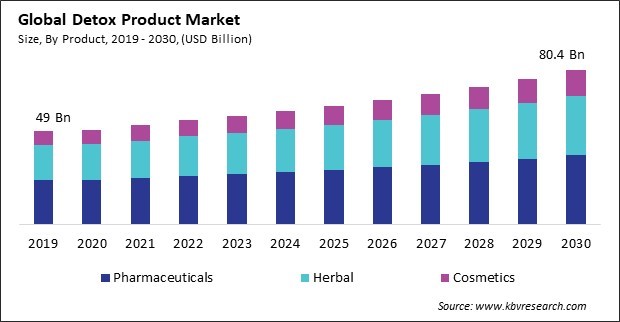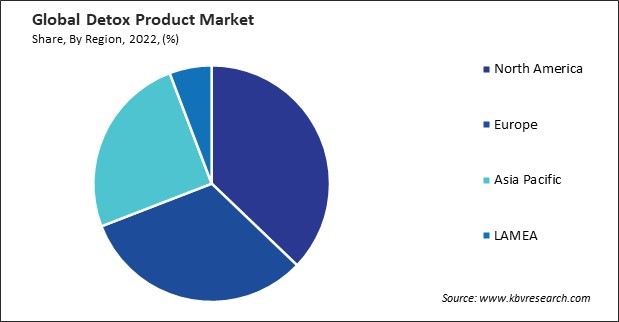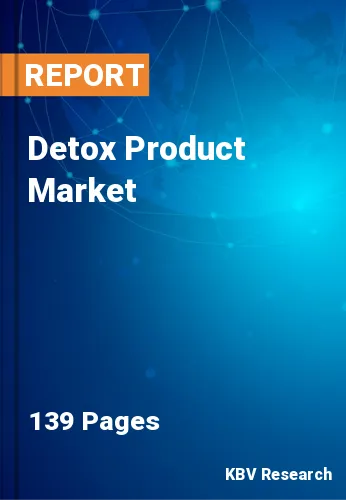“Global Detox Product Market to reach a market value of USD 80.4 Billion by 2030 growing at a CAGR of 5.1%”
The Global Detox Product Market size is expected to reach $80.4 billion by 2030, rising at a market growth of 5.1% CAGR during the forecast period.
An escalating number of North American consumers are adopting a proactive stance toward preserving their health and wellness. Therefore, the North America region captured $20,269.8 million revenue in the market in 2022. The high obesity rates in Canada can have a significant impact on the market. As obesity rates continue to rise, individuals may increasingly seek solutions to manage their weight, improve their health, and address related health concerns. As per the Government of Canada, about 1 in 4 Canadian adults (26.6%) are currently living with obesity. Obesity rates in Canadian adults are higher in men compared to women (28.0% versus 24.7%, respectively). In rural areas, about 1 in 3 Canadian adults are living with obesity (31.4%). Furthermore, in urban areas, about 1 in 4 Canadian adults are living with obesity (25.6%).

As health consciousness rises, individuals are progressively more inclined to embrace healthier lifestyles and make well-informed decisions regarding their dietary and overall lifestyle choices. Detox products are often perceived as a way to support overall well-being by removing toxins from the body and promoting better health. Many consumers view detoxification as a proactive measure to prevent illness and promote longevity. Customers see it as a way to rid the body of harmful substances and reduce the risk of disease, aligning with the broader trend of preventive healthcare. Additionally, the clean label movement, emphasizing transparency and simplicity in product ingredients, has gained momentum in recent years. Consumers are scrutinizing product labels and seeking products with recognizable, natural ingredients, driving demand for natural and organic products. The potential health hazards linked to synthesized preservatives, additives, and artificial ingredients frequently encountered in processed food and consumer goods elicit apprehension among many consumers. Natural and organic products are considered safer and purer alternatives, free from potentially harmful chemicals. Therefore, the growing interest in natural and organic products drives the market's growth.
However, Consumer resistance and doubt may result from the absence of scientific evidence substantiating the effectiveness and safety of this. Many consumers are increasingly cautious about investing in products that lack credible scientific backing, especially concerning matters related to their health and well-being. Without scientific evidence, some manufacturers of this may resort to making exaggerated or misleading claims about the benefits of their products. This can contribute to consumer confusion and misinformation, leading to unrealistic expectations and potential disappointment with the results of detox regimens. When scientific evidence does not substantiate product claims, scrutiny from regulators, caution letters, and even penalties may ensue. Hence, the lack of scientific evidence is hampering the market's growth.
Based on product, the market is divided into pharmaceuticals, herbals, and cosmetics. In 2022, the pharmaceuticals segment garnered the highest revenue share in the detox product market. Pharmaceutical-grade detox products undergo rigorous testing and clinical trials, giving consumers confidence in their efficacy and safety compared to non-pharmaceutical alternatives. Healthcare professionals often recommend pharmaceutical-grade detox products due to their proven effectiveness and ability to address specific health concerns, increasing consumer trust and demand.

Region-wise, the market is analyzed across North America, Europe, Asia Pacific, and LAMEA. In 2022, the Europe region generated a substantial revenue share in the market. European consumers strongly prefer natural, organic, and environmentally friendly products. made from natural and plant-based ingredients are highly sought after, as they align with consumers' sustainability, purity, and environmental responsibility values. Hence, the preference for natural products is propelling the market's growth in the region.
Free Valuable Insights: Global Detox Product Market size to reach USD 80.4 Billion by 2030
| Report Attribute | Details |
|---|---|
| Market size value in 2022 | USD 54.6 Billion |
| Market size forecast in 2030 | USD 80.4 Billion |
| Base Year | 2022 |
| Historical Period | 2019 to 2021 |
| Forecast Period | 2023 to 2030 |
| Revenue Growth Rate | CAGR of 5.1% from 2023 to 2030 |
| Number of Pages | 139 |
| Number of Tables | 170 |
| Report coverage | Market Trends, Revenue Estimation and Forecast, Segmentation Analysis, Regional and Country Breakdown, Porter’s 5 Forces Analysis, Company Profiling, Companies Strategic Developments, SWOT Analysis, Winning Imperatives |
| Segments covered | Product, Region |
| Country scope |
|
| Companies Included | Novartis AG, Pfizer, Inc., Teva Pharmaceutical Industries Ltd., Himalaya Global Holdings Ltd., Mallinckrodt PLC, Daiichi Sankyo Company, Limited, Sun Pharmaceutical Industries Ltd., Bioforce, Herbalife nutrition Ltd., Amway Corporation |
By Product
By Geography
This Market size is expected to reach $80.4 billion by 2030.
Increasing health consciousness among consumersare driving the Market in coming years, however, Lack of scientific evidence restraints the growth of the Market.
Novartis AG, Pfizer, Inc., Teva Pharmaceutical Industries Ltd., Himalaya Global Holdings Ltd., Mallinckrodt PLC, Daiichi Sankyo Company, Limited, Sun Pharmaceutical Industries Ltd., Bioforce, Herbalife nutrition Ltd., Amway Corporation
The expected CAGR of this Market is 5.1% from 2023 to 2030.
The North America region dominated the Market by Region in 2022, and would continue to be a dominant market till 2030; there by, achieving a market value of $28.7 billion by 2030.
Our team of dedicated experts can provide you with attractive expansion opportunities for your business.

 Drivers
Drivers
 Restraints
Restraints
 Opportunities
Opportunities
 Challenges
Challenges
